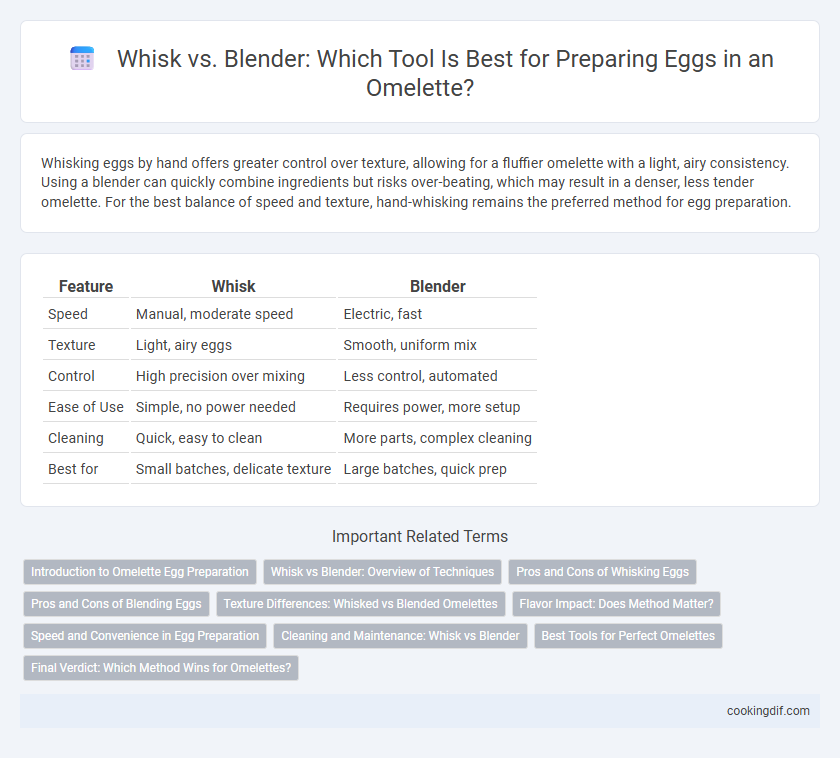Whisking eggs by hand offers greater control over texture, allowing for a fluffier omelette with a light, airy consistency. Using a blender can quickly combine ingredients but risks over-beating, which may result in a denser, less tender omelette. For the best balance of speed and texture, hand-whisking remains the preferred method for egg preparation.
Table of Comparison
| Feature | Whisk | Blender |
|---|---|---|
| Speed | Manual, moderate speed | Electric, fast |
| Texture | Light, airy eggs | Smooth, uniform mix |
| Control | High precision over mixing | Less control, automated |
| Ease of Use | Simple, no power needed | Requires power, more setup |
| Cleaning | Quick, easy to clean | More parts, complex cleaning |
| Best for | Small batches, delicate texture | Large batches, quick prep |
Introduction to Omelette Egg Preparation
Whisking eggs for an omelette creates a light, airy texture by incorporating air, essential for fluffy results and even cooking. A blender offers speed and convenience, efficiently mixing eggs while ensuring uniform consistency but may overmix, affecting texture. Choosing between a whisk and blender depends on desired omelette fluffiness and preparation time.
Whisk vs Blender: Overview of Techniques
A whisk allows precise control over the egg's texture, incorporating air slowly and ensuring a light, fluffy omelette with a delicate consistency. A blender rapidly agitates the eggs, producing a uniformly mixed batter but potentially over-beating and leading to a denser, less tender result. Skillful whisking enhances omelette quality through gradual aeration, while blenders prioritize speed and convenience with slightly different texture outcomes.
Pros and Cons of Whisking Eggs
Whisking eggs provides better control over the texture, allowing for a light, fluffy omelette with minimal air incorporation compared to a blender. It requires less cleanup and avoids over-mixing, preserving the eggs' natural structure and taste. However, whisking can be more time-consuming and physically demanding, especially when preparing large quantities.
Pros and Cons of Blending Eggs
Using a blender for egg preparation offers quick and uniform mixing, which results in a consistently smooth texture ideal for omelettes. However, blending can introduce excess air, leading to a fluffier but sometimes less stable omelette structure. While efficient, the blender may overwork the eggs, impacting the final taste and potentially causing a rubbery texture if overblended.
Texture Differences: Whisked vs Blended Omelettes
Whisking eggs incorporates air gradually, resulting in a light, fluffy texture with distinct curds in an omelette. Blending eggs, on the other hand, creates a smoother mixture by breaking down proteins more thoroughly, producing a consistent, custard-like texture. Choosing between whisking and blending directly impacts the omelette's tenderness and mouthfeel, with whisking favoring fluffiness and blending favoring uniformity.
Flavor Impact: Does Method Matter?
Whisking eggs by hand incorporates air gently, preserving a delicate texture and enhancing natural egg flavor, while using a blender can lead to over-aeration, resulting in a slightly metallic or processed taste. The mechanical intensity of blenders tends to break down egg proteins more aggressively, which can alter flavor perception and texture density. For optimal flavor and texture in an omelette, hand whisking is preferred to maintain the eggs' natural richness and subtle taste nuances.
Speed and Convenience in Egg Preparation
Whisking eggs by hand offers precise control over texture, allowing gentle incorporation of air for fluffy omelettes, but requires more time and manual effort compared to blenders. Blenders excel in speed and convenience, quickly combining eggs with other ingredients to create a smooth mixture ideal for fast meal preparation. For those prioritizing efficiency, blenders significantly reduce prep time, while whisking remains preferred for culinary finesse and texture control.
Cleaning and Maintenance: Whisk vs Blender
Whisks require simple cleaning by hand or dishwasher, with fewer parts prone to buildup, making maintenance straightforward and quick. Blenders often have multiple components, including blades and containers, which require thorough disassembly and washing to prevent residue and odors. Regular deep cleaning of blender parts is essential to ensure hygiene, while whisks generally demand less effort for upkeep.
Best Tools for Perfect Omelettes
Whisks offer precise control and aerate eggs gently, making them ideal for fluffy omelettes, while blenders quickly emulsify eggs but risk overbeating, resulting in denser texture. Professional chefs often prefer stainless steel whisks for their balance and durability, ensuring consistent, smooth egg mixtures. For perfect omelettes, using a balloon whisk optimizes texture by incorporating just enough air without breaking egg structure.
Final Verdict: Which Method Wins for Omelettes?
Whisking eggs by hand offers better control over texture, resulting in a light, fluffy omelette with distinct air pockets, while a blender quickly achieves a uniformly smooth mixture but can over-aerate eggs, leading to a denser omelette. Chefs often prefer whisking for classic omelettes due to the delicate folding and consistent curd size it produces. The final verdict favors whisking as the superior method for achieving optimal omelette texture and flavor.
Whisk vs Blender for egg preparation Infographic

 cookingdif.com
cookingdif.com